Being a globalised staple of flowering plants, Forget Me Not flowers are the perfect addition to any garden where their delicate soft-blue flowers and attractive upright form offer growers a handful of ornamental and practical applications within their landscapes.
They are low-maintenance and can grow in almost any conditions so they are perfect for beginner and expert growers alike looking to establish a perennial flowering plant in their gardens or homes.
Here is everything you need to know to grow and care for Forget Me Not flowers in Australia.
More...
Genus: | Myosotis |
|---|---|
Species: | scorpioides |
Family: | Boraginaceae |
Common Names: | Forget me not flowers, scorpion grass |
Location: | Indoor or outdoor |
Type: | Flowering plant |
Growth: | 15 to 30 centimetres tall, 30 centimetres wide |
Sun requirements: | Full sun to part shade |
Foliage Colour: | Green |
Flower Colour: | Light blue |
Flowering: | Spring to summer |
Maintenance level: | Low |
Poisonous for pets: | Non-toxic to cats and dogs |
Introducing Forget Me Not Flowers
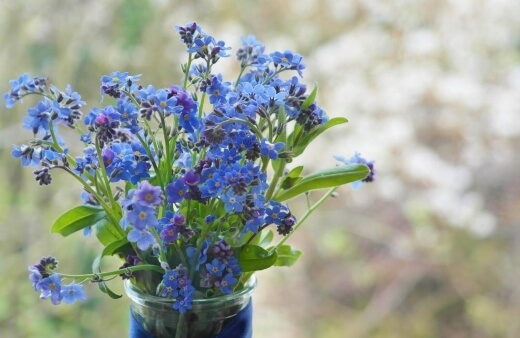
Though short-lived, taking only two years to reach their full lifecycle where they flower profusely, forget me nots are self-seeding plants that will scatter themselves across the garden, ensuring new blooms almost always.
They are perfect for even shady spots in the garden and the small clustered flowers make for brilliant-cut flowers for arrangements and additional decoration around the house.
Some varieties offer white, pink and even yellow blooms so there’s bound to be the perfect pick for your needs. Be sure to check out our Lily of the Valley growing guide which goes perfectly with Forget Me Nots.
Botanically known as Myosotis scorpioides (formerly Myosotis palustris), these herbaceous perennial flowering plants form a part of the family Boraginaceae and are native to Europe, Asia and other regions within the northern hemisphere.
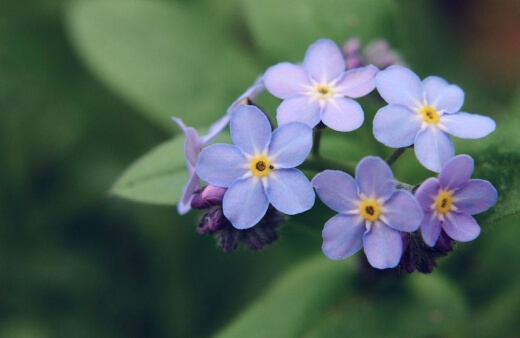
Today, they are widely distributed globally, often seen in flower shops, funeral arrangements and even many corporate functions.
They naturally occur largely and thrive in moist and humid environments, often near sources of water. Another very common name is scorpion grass, loosely derived from the species name.
In cultivation, they usually grow to around 15 to 30 centimetres tall and 30 centimetres wide but they are known to grow a little taller in optimised environments. They feature 5-petaled blue flowers with yellow eyes atop long hairy stems and oblong to linear hairy leaves.
They make for excellent potted plants but they can also be used for decorative edging in the garden, in rockeries, used as groundcover or used to fill sparse beds in cottage-style gardens where planted alongside spring tulips, creates a magical appeal to the space.
Popular Forget Me Not Varieties
Wood Forget Me Not (Myosotis sylvatica)
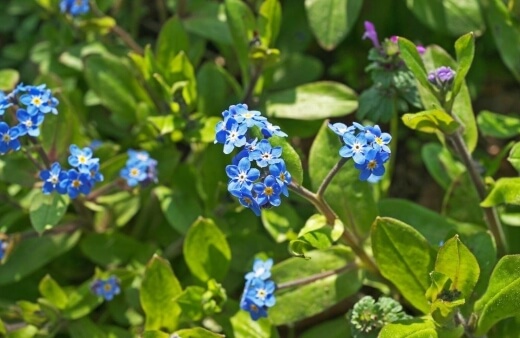
Known as “Wood Forget Me Not” or “Woodland Forget Me Not”, this variety is native to Europe and features many of the same looks and growing habits as its close relative. Popular cultivars include “Blue Basket”, “Music” and “Snowball”.
Alpine Forget Me Not (Myosotis alpestris)

Known as “Alpine Forget Me Not”, it is a variety that offers a multitude of bloom colours including blue, pink and white. Naturally occurring in mountainous areas on wooded slopes and grassy meadows, this plant is also the state flower of Alaska.
Smaller Forget Me Not (Myosotis laxa)
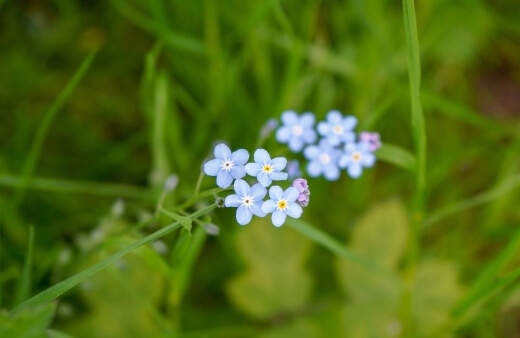
Common names include “Tufted Forget Me Not” and “Small-Flowered Forget Me Not”, this variety occurs almost exclusively in the northern hemisphere and produces smaller purply-white flowers with an upright compact growing habit.


Get Your Free Guide:
Master Growing Australian Natives eBook
A Must Have Complete Guide for Every Australian Garden
Get Your Free Guide:
Master Growing Australian Natives eBook
A Must Have Complete Guide for Every Australian Garden
How to Grow Forget Me Nots
Scorpion grass is best propagated by seeds or by the division of its clumps. Seeds should only be sown or divided plants should only be struck once the danger of frost has passed which is usually around early to mid-spring.
There are a multitude of local nurseries or online retailers that sell healthy seeds in batches. If using division, be sure to use a healthy and disease-free donor plant.
Alternatively, young and healthy plants will be readily available at your local nurseries or online for transplanting.

Best Conditions for Planting Forget Me Not Flowers
These plants need high moisture and humidity environments to survive and flower best. That makes them perfect for landscaping near ponds, watery rockeries or in wilder gardens with natural sources of water nearby like streams.
They self-seed for many years and don’t require overly complicated growing conditions. They are known to be able to grow well in most climates, especially in our endemic conditions.
Lighting Needs
Though it can tolerate full sun, partial shade is recommended for this plant. Some direct full sun each day is fine but a large portion of afternoon shade will ensure a brighter, more vibrant flower colour.
Best Soil to Use
Average soil types can work as long as they are kept moist. The soil must be well-draining so enriching garden beds with some compost is never a bad idea. For potted plants, a quality potting mix will work great.
Spacing for Mass Planting
Plant 10 to 12 centimetres apart when looking at establishing more than one plant in your landscape.
How to Propagate Forget Me Not

Growing Scorpion Grass from Seeds
- Sow your seeds outside in a garden bed enriched with compost or in a container filled with a high-quality potting mix. Be sure to only cover the seeds lightly with soil.
- Your entire layer of soil shouldn’t be too deep. The recommended thickness of your garden soil layer is around 5 to 10 centimetres at most.
- Thin your seeds across the soil on your bed to create a space of about 25 centimetres between the plants. This will ensure proper growing space for each plant.
- Water lightly after sowing the seeds and keep the soil moist but never soggy.
- For container sowing, place the seeds in a warm and humid location.
- Ensure there is some form of protection from strong winds while the seeds develop.
- You can expect germination within 10 to 14 days. This may take a little longer in cooler conditions.
- Once you start to see new growth, allow the seedlings to develop for another few months before transplanting or repotting them.
Propagating Forget Me Not Using Division
- Established plants can be divided to make new plants.
- Gently lift the donor plant from its soil, being careful not to disturb the roots as much as possible.
- Using a sharp spade or shovel, cleanly cut the plant into entire clumps. Each clump should have a healthy number of roots, stems, foliage and flowers. Don’t cut your plant into too many clumps, for a plant this size maybe about 2 to 3 clumps at most.
- Prepare new planting holes in your garden bed enriched with compost and place the divided plants into these holes, securing them and backfilling with soil once in place.
- For containers, always use a quality potting mix and containers that feature good drainage.
- Water well after planting the divided plants to help settle them in the new soil.
- Keep the soil moist as they develop but never soggy.
- Feed with a balanced liquid fertiliser at half strength to encourage faster development in the warmer months.
Quick Tips on How to Scorpion Grass

Planting Forget Me Not in the Garden
- Choose a position in your garden with some full sun and mostly partial shade.
- Prepare your bed by adding some compost to enrich the existing soil.
- Seeds can be sown directly into the ground, only lightly being covered by soil.
- Young nursery plants can also be planted straight into the ground.
- Seeds that have just been sown may need some extra protection from harsh light as they develop until germination. You can use cardboard or a garden umbrella to assist.
- Water gently once planted throughout the germination phase.
- Once your seedlings are about 5 to 10 centimetres tall, you can consider mulching with an organic mulch like bark chips or pea straw.
- Feed every fortnight with a balanced garden fertiliser during the growing season.
Planting Forget Me Not in a Container
- Your container should be at least 20cm wide and deep. Position in a spot with some full sun and mostly part shade.
- Always try to use a quality potting mix available at local nurseries and plant centres.
- Seeds sown into containers should also only be covered lightly with soil and also protected from harsh light during development until germination.
- Water lightly to keep the soil moist but never wet.
- After germination, you can consider feeding with a balanced garden fertiliser every two weeks during the growing season.
How to Care for Forget Me Not Flowers

Watering Schedule
In drier areas or long periods of hot and dry weather, your plant will need more frequent waterings. In general, water regularly to keep the soil moist but never wet and soggy.
To prevent possible fungal issues and spotting, water only the soil at the base of the plant and avoid the leaves and stems.
Fertilising for Bountiful Flowers
A general-purpose fertiliser applied every 1 to 2 weeks during the growing seasons should help your plant thrive and produce more flowers. For potted indoor plants, a balanced houseplant fertiliser is recommended.
Refer to: Australian Garden Fertiliser 2023 Users Guide
Mulching Needs
In cooler climates or during cold months, you can mulch with an organic mulch to help protect your plant against cold temperatures. This will also help the soil retain more moisture which is essential for scorpion grass.
Pruning
Being one the easiest flowers to grow, you’ll want to lightly prune them back if they start to spread too much and lose their shape and form. Prune after the flowering season for the best results.
Forget Me Not Possible Pests, Problems & Diseases
Potted forget me nots rarely struggle with any pest issues. However, garden-planted flowers can attract some unwanted visitors. When it comes to diseases, they can also be susceptible to certain issues.
Luckily, all of these problems are usually minor and easily combated.
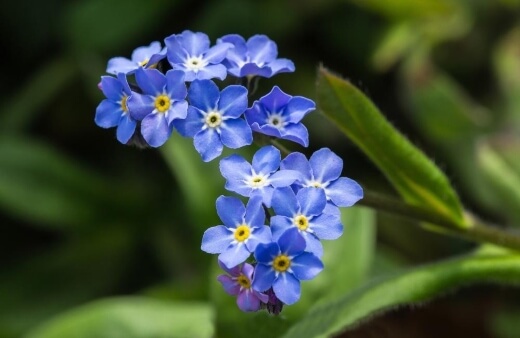
Aphids
These sap-sucking little insects can be identified on the undersides of the leaves. They look similar to little potatoes on the foliage and they don’t move once they start feeding on the plant.
To quickly treat this and get rid of them, you can spray them off with water or manually wipe them away with a soft cloth.
Slugs & Snails
These guys usually feast on the plant during the night so if you notice foliage disappearing, be sure to go out at night to see if it is in fact slugs or snails causing the problem.
They can be treated by using a garden insecticide or fungicide or picked off by hand and placed in a bucket filled with soapy water to stop them from coming back.
Powdery Mildew
Often occurring as leaf spots or white rust on the upper and lower sides of the foliage, this fungal disease can also luckily be treated quite easily. It usually appears after flowering.
To combat these harmful pathogens, be sure that your plant is receiving plenty of good air circulation, remove any affected foliage as soon as possible and treat with a fungicide every three weeks to help reduce the issue and hopefully clear it eventually.
Forget Me Not Frequently Asked Questions
Do forget-me-nots grow back every year?
Most of the varieties are perennials that return and spread each year through their seeds. These plants specifically have a strong reputation for spreading, hence why they are considered invasive in many regions of the world.
Are forget-me-nots hardy?
Yes, they are very hardy plants. They can die back in cold winters but will resprout in the next spring with ease.
What does a forget-me-not smell like?
Many say they smell like a fresh flower garden after a spring rain. The scent is soft and florally with citrusy notes. This is a big reason why they are so notorious in fresh flower arrangements.
If you’re interested in also growing excellent native flowers, be sure to have a look at our other informative guide below:
Make Your Home Unforgettable with Forget Me Not Flowers
It’s easy to see why these cheerful flowers have become such a staple in gardens and homes across the globe. With their perky, delicate light-blue flowers, pleasant scent and attractive form, they can quickly spruce up any space.
Being very easy to grow and with their quick-spreading nature, you can be sure you’ll have an impressive addition and enjoy your bountiful blue blooms almost all the time.
Growers have a few stunning varieties to choose from so you’re bound to find the right forget me not for your gardening needs.
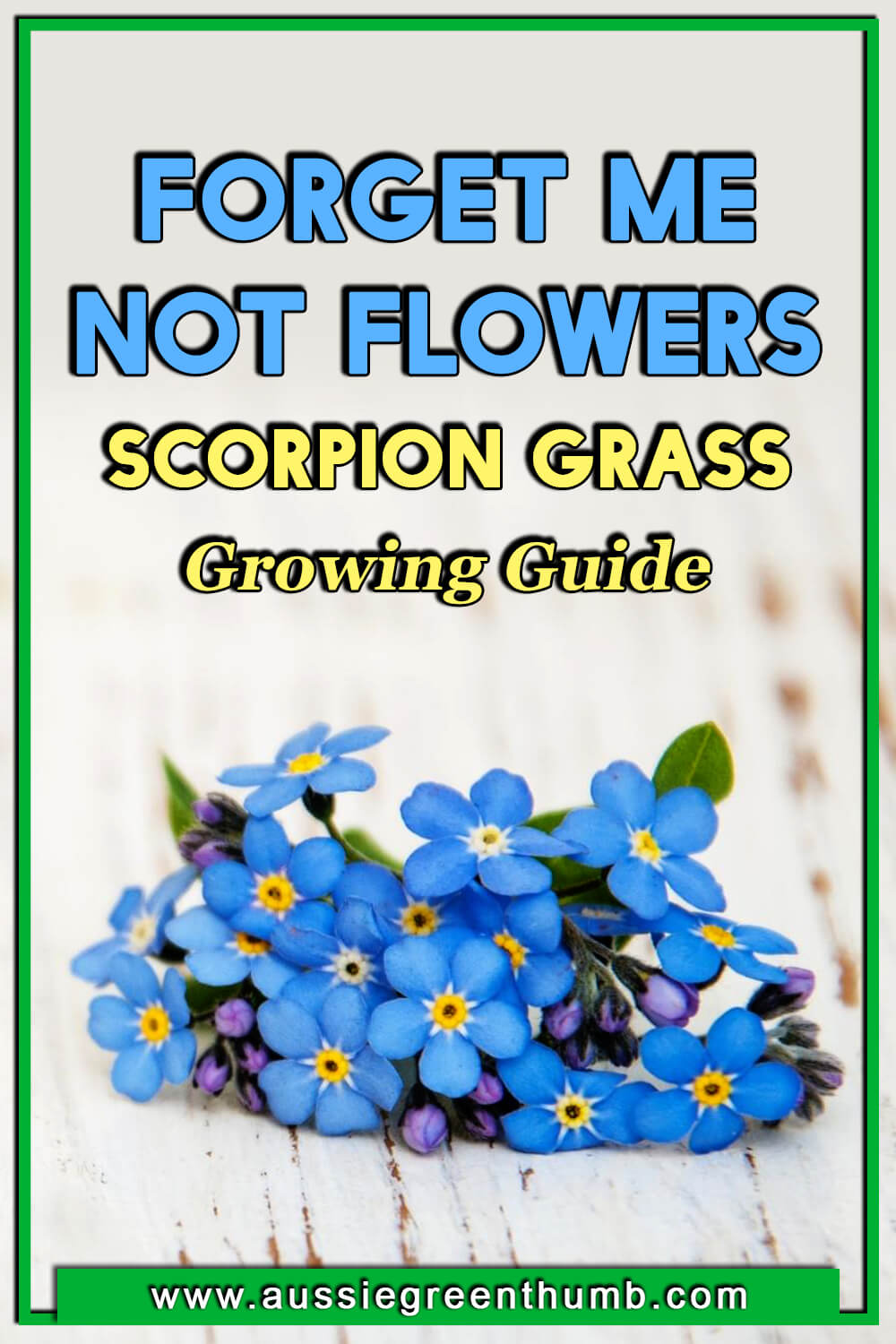
Published on June 23, 2022 by Maisie Blevins
Last Updated on October 4, 2024




